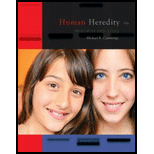
Concept explainers
James sees an online ad for an at-home genetic test that promises to deliver personalized nutritional advice based on an individual’s genetic profile. The company can test for
Once the kits arrive, the family members use cotton swabs to take cell samples from their cheeks and place the swabs in individually labeled envelopes. They mail the envelopes back to the company, along with completed questionnaires regarding their diets. Four weeks later, they receive three individual reports detailing the test results and providing extensive guidelines about what foods they should eat. Among the results is the finding that James has a particular allele in a gene that may make him vulnerable to the presence of free radicals in his cells. The report suggests that he increase his intake of antioxidants, such as vitamins C and E, and highlights a number of foods that are rich in those vitamins. The tests also show that Sally has several genetic variations that indicate that she may be at risk for elevated bone loss. The report recommends that she try to minimize this possibility by increasing her intake of calcium and vitamin D and lists a number of foods she could emphasize in her diet. Finally, the report shows that Patty has a genetic variation that may mean that she has a lowered ability to metabolize saturated fats, putting her at risk for developing heart disease. The report points to ways in which she can lower her intake of saturated fats and lists various types of foods that would be beneficial for her.
A number of companies now offer genetic-testing services, promising to deliver personalized nutritional or other advice based on people’s genetic profiles. Generally, these tests fall into two different categories, with individual companies offering unique combinations of the two. The first type of test detects alleles of known genes that encode proteins that play an established role in, for example, counteracting free radicals in cells or in building up bone. In such cases, it is easy to see why individuals carrying alleles that may encode proteins with lower levels of activity may be more vulnerable to free radicals or more susceptible to bone loss.
A second type of test examines genetic variations that may have no clear biological significance (i.e., they may not occur within a gene or may not have a detectable effect on gene activity) but have been shown to have a statistically significant correlation with a disease or a particular physiological condition. For example, a variation may frequently be detected in individuals with heart disease even though the reason for the correlation between the variation and the disease may be entirely mysterious.
Do you think parents should be able to order such a test for their children? What if the test indicates that a child is at risk for a disease for which there is no known cure?
Want to see the full answer?
Check out a sample textbook solution
Chapter 15 Solutions
Human Heredity: Principles and Issues (MindTap Course List)
- Describe the levels of structural hierarchy for the human body, starting with the organismal level and ending with the chemical level. In addition, you should make sure you link each level to the previous level, emphasizing the structural relationships.arrow_forward9 S es Read the section "Investigating Life: In (Extremely) Cold Blood." Then, drag and drop the terms on the left to complete the concept map. Red blood cells Genes Icefishes -have mutated have colorless Oxygen have few lack encode Blood Cellular respiration consists of- contain carries is a Platelets White blood cells carries low amounts of Hemoglobin is necessary for Plasma Protein Reset.arrow_forwardPlating 50 microliters of a sample diluted by a factor of 10-6 produced 91 colonies. What was the originalcell density (CFU/ml) in the sample?arrow_forward
- Every tutor here has got this wrong, don't copy off them.arrow_forwardSuppose that the population from question #1 (data is in table below) is experiencing inbreeding depression (F=.25) (and no longer experiencing natural selection). Calculate the new expected genotype frequencies (f) in this population after one round of inbreeding. Please round to 3 decimal places. Genotype Adh Adh Number of Flies 595 Adh Adh 310 Adhs Adhs 95 Total 1000 fladh Adh- flAdn Adh fAdhs Adharrow_forwardWhich of the following best describes why it is difficult to develop antiviral drugs? Explain why. A. antiviral drugs are very difficult to develop andhave no side effects B. viruses are difficult to target because they usethe host cell’s enzymes and ribosomes tometabolize and replicate C. viruses are too small to be targeted by drugs D. viral infections usually clear up on their ownwith no problemsarrow_forward
- This question has 3 parts (A, B, & C), and is under the subject of Nutrition. Thank you!arrow_forwardThey got this question wrong the 2 previous times I uploaded it here, please make sure it's correvct this time.arrow_forwardThis question has multiple parts (A, B & C), and under the subject of Nutrition. Thank you!arrow_forward
- Calculate the CFU/ml of a urine sample if 138 E. coli colonies were counted on a Nutrient Agar Plate when0.5 mls were plated on the NA plate from a 10-9 dilution tube. You must highlight and express your answerin scientific notatioarrow_forwardDon't copy off the other answer if there is anyarrow_forwardAnswerarrow_forward
 Human Heredity: Principles and Issues (MindTap Co...BiologyISBN:9781305251052Author:Michael CummingsPublisher:Cengage Learning
Human Heredity: Principles and Issues (MindTap Co...BiologyISBN:9781305251052Author:Michael CummingsPublisher:Cengage Learning- Case Studies In Health Information ManagementBiologyISBN:9781337676908Author:SCHNERINGPublisher:Cengage
 Nutrition Through The Life CycleHealth & NutritionISBN:9781337919333Author:Brown, Judith E.Publisher:Cengage Learning,
Nutrition Through The Life CycleHealth & NutritionISBN:9781337919333Author:Brown, Judith E.Publisher:Cengage Learning,





